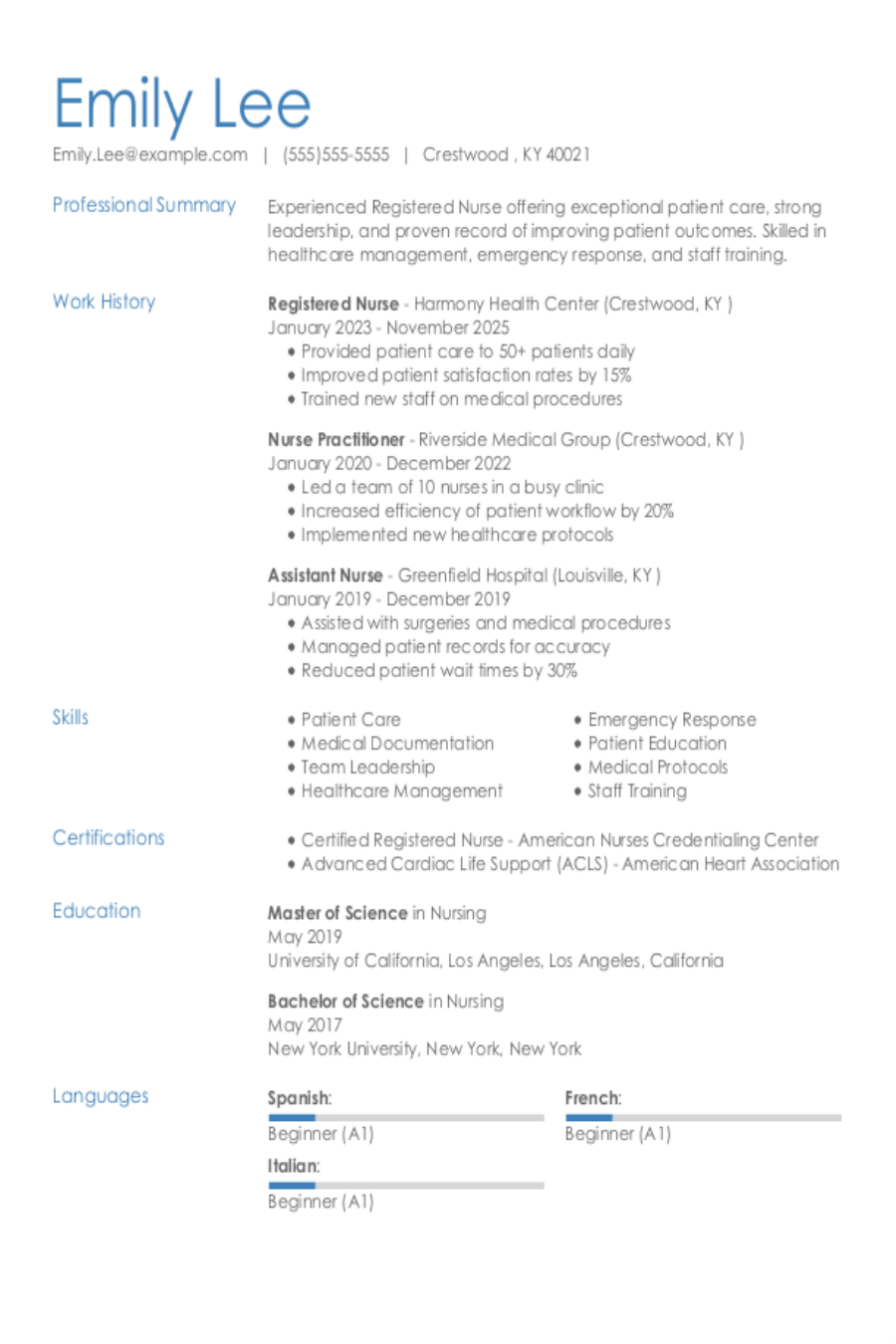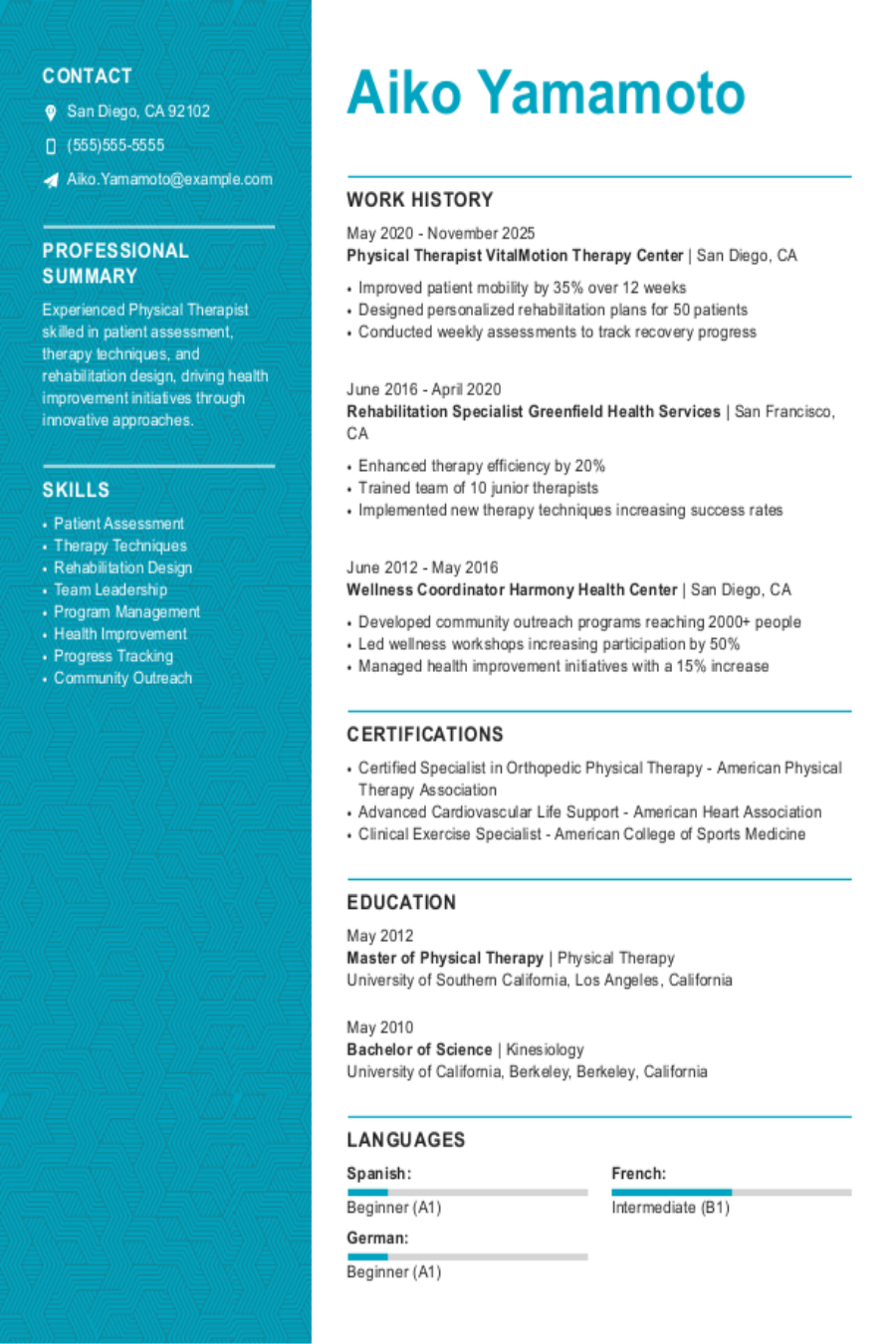Table of contents
Popular Truck Driver Resume Examples
Entry-level truck driver resume
An entry-level resume for a truck driver should emphasize a clean driving record, relevant certifications like CDL, safety training, and skills such as navigation and punctuality.
Places skills over experience: Using a functional resume format strategically highlights my logistics expertise and key skills, such as route optimization and cargo delivery, over my limited work history. This approach makes me a strong job seeker for truck driving positions.
Showcases education: The applicant effectively highlights certifications by including a Certified Logistics Associate credential and a Hazardous Materials Endorsement. These qualifications demonstrate their expertise in logistics and compliance, improving their suitability for truck driving positions.
Mid-career Truck Driver resume
A mid-career truck driver resume should emphasize a strong combination of driving experience, safety records, specialized skills, and continuous professional development to attract potential employers in the industry.
Employs active language: action verbs like "transported," "improved," and "handled" illustrate a proactive approach and significant contributions in the trucking field, showcasing measurable achievements.
Begins with a powerful summary: The resume profile shows the applicant's expertise in logistics and safety compliance, making it easy for recruiters and ATS to spot relevant skills and accomplishments.
Experienced Truck Driver resume
An experienced truck driver resume should prioritize showcasing driving records, safety achievements, and the ability to handle diverse routes effectively to demonstrate professionalism and reliability.
Highlights experience: The resume opens with a strong summary that emphasizes the applicant’s extensive background in trucking and logistics. This immediately establishes professionalism and reassures recruiters of the applicant's reliability and expertise.
Follows traditional format: The chronological resume format effectively highlights the extensive experience of the job seeker, making it easy for potential employers to follow their career progression through a clear timeline of roles and achievements in the trucking industry.
No experience Truck Driver resume
A resume for an applicant with no experience should focus on relevant skills, certifications, and any hands-on experiences that demonstrate the ability to operate vehicles safely and efficiently.
Favors clarity over complexity: The resume's straightforward design highlights relevant logistics and transportation experience, effectively presenting qualifications without unnecessary clutter.
Leads with education: Including relevant coursework in logistics management, such as transport operations and safety regulations, equips the job seeker with essential skills for a truck driver role, effectively overshadowing limited practical experience.
More resume examples
Truck Driver Resume Template
Looking to kickstart your career? This truck driver resume template provides a solid foundation — simply copy it and personalize it with your own details.
Olivia Kim
Oakridge, OR 97473
(555)555-5555
Olivia.Kim@example.com
Professional Summary
Experienced truck driver with a background in logistics and fleet coordination, achieving high delivery efficiency and precision. Proficient in route planning and safety compliance.
Skills
- Route Planning
- Cargo Management
- Fleet Coordination
- Safety Compliance
- Load Optimization
- Time Management
- Vehicle Maintenance
- Technology Proficiency
Certifications
- Certified Professional Logistician - American Society of Transportation and Logistics
- Hazardous Materials Endorsement - US Department of Transportation
Education
Master of Business Administration Logistics and Supply Chain Management
Texas State University San Marcos, Texas
May 2016
Bachelor of Arts Transportation and Logistics
University of Texas at Austin Austin, Texas
May 2014
Work History
Truck Driver
BlueLine Transport - Oakridge, OR
May 2022 - September 2025
- Delivered goods on time, achieving 98% punctuality
- Managed cargo for maximum space utilization
- Executed daily vehicle inspections, reducing breakdowns
Logistics Coordinator
Summit Freight Lines - Oakridge, OR
March 2019 - April 2022
- Optimized routes, saving 20% fuel costs annually
- Coordinated shipments with zero delivery errors
- Implemented tracking system, increasing efficiency 15%
Driver Assistant
Horizon Logistics - Oakridge, OR
September 2017 - February 2019
- Supported loading, enhancing speed by 10%
- Assisted driver in navigation, reducing travel time
- Maintained records accurately, boosting audit success
Languages
- Spanish - Beginner (A1)
- German - Intermediate (B1)
- French - Beginner (A1)
Must-Have Skills on a Truck Driver Resume
A well-crafted skills section can significantly improve your resume, making it stand out to potential employers.
This data provides insights into the most sought-after hard and soft skills for a truck driver according to Resume Now’s internal resume data.
When you’re ready to elevate your resume, check out our AI Resume Skills Generator. It will recommend both hard and soft skills tailored to your job title, ensuring a comprehensive and personalized skill set.
Writing Your Truck Driver Resume
Now that you've explored these effective resume examples, it's time to dive into the details of how to write a resume. We'll guide you through each section step by step, ensuring you create a compelling document that stands out.
List your most relevant skills
An effective skills section on your truck driver resume is important for showcasing your qualifications. Focus on both technical abilities, such as driving skill and safety regulations, as well as soft skills like time management and communication. When you tailor this section, make sure to identify the keywords from the job listing that highlight what employers are seeking.
Incorporating these keywords not only captures the attention of human recruiters but also boosts your chances with applicant tracking systems. By aligning your skills with the specific requirements mentioned in the job description, you present yourself as a strong job seeker ready to meet their needs. Remember, clarity and relevance are key in making a lasting impression.
Example of skills on a truck driver resume
- Proficient in operating various types of trucks and vehicles safely
- Strong knowledge of transportation regulations and safety protocols
- Excellent time management skills to ensure timely deliveries
- Adaptable team player with a commitment to customer service
An effective skills section for a truck driver should highlight both technical skills outlined in the job description and essential soft skills, such as communication and time management. This combination demonstrates your readiness to meet the demands of the role while ensuring safety and efficiency on the road. Employers value job seekers who can balance technical expertise with interpersonal abilities.
Highlight your work history
Your work experience section is a key part of your truck driver resume, showcasing achievements on the road rather than just listing duties. Highlighting accomplishments like safe driving records or successful deliveries shows how you effectively used your skills in high-pressure situations.
For each job entry, include essential information such as your title, company name, and dates of employment. This allows potential employers to verify your background and understand the breadth of your trucking industry experience while reinforcing your professionalism and reliability.
Example of a truck driver work experience entry
- Truck Driver
Swift Transportation - Phoenix, AZ
January 2021 - Present - Transport an average of 10-12 loads weekly across the Southwest region while maintaining a 98% on-time delivery rate
- Conduct thorough pre-trip and post-trip inspections to ensure vehicle safety and compliance with DOT regulations, resulting in zero violations during audits
- Use GPS technology to optimize routes, reducing fuel consumption by 15% and improving overall delivery efficiency
- Provide exceptional customer service during drop-offs, addressing client needs proactively and contributing to positive feedback from over 95% of customers
- Mentor new drivers on best practices for safe driving, load handling, and regulatory compliance, improving their transition into the role.
Quantifying achievements as a truck driver is essential to illustrate your reliability and efficiency. For example, stating that you maintained a 98% on-time delivery rate over the past year clearly demonstrates your commitment to punctuality and customer satisfaction.
Include your education
The education section of your truck driver resume should be organized in reverse-chronological order, starting with your most recent qualifications. Include any relevant training programs, certifications, and degrees while omitting your high school diploma if you hold a higher credential. This clarity helps potential employers quickly assess your qualifications.
For those currently pursuing educational opportunities or who have incomplete credentials, it is important to list your highest completed level alongside an expected graduation date. Additionally, consider including bullet points for applicable coursework or significant achievements that showcase skills relevant to trucking. This information can strengthen your application especially if you are a recent graduate or still in training.
Common certifications for a truck driver resume
- Commercial Driver’s License (CDL) – Federal Motor Carrier Safety Administration (FMCSA)
- Hazardous Materials Endorsement (H) – Federal Motor Carrier Safety Administration (FMCSA)
- Tank Vehicle Endorsement (N) – Federal Motor Carrier Safety Administration (FMCSA)
- Transportation Worker Identification Credential (TWIC) – Transportation Security Administration (TSA)
Sum up your resume with an introduction
Creating a compelling profile section on your resume is important as it sets the tone for your application. This part of your resume serves as a snapshot, giving employers insight into your qualifications and what you bring to the table. A well-crafted profile can grab attention and motivate hiring managers to delve deeper into your experience.
If you have substantial experience, a professional summary is the way to go. This format allows you to showcase key accomplishments and relevant skills right at the forefront of your resume. Highlighting significant achievements quickly conveys your value, making it easier for recruiters to see how you align with their needs.
Professional summary example
Dedicated truck driver with over 10 years of experience in long-haul transportation. Demonstrated success in delivering shipments on time while maintaining a stellar safety record and adhering to all regulations. Proficient in route optimization, vehicle maintenance, and customer service, ensuring efficient and reliable service delivery.
Resume objective example
Enthusiastic truck driver eager to use strong navigation and communication skills to improve logistical efficiency for a reputable transportation company. Committed to ensuring timely deliveries while maintaining safety standards, aiming to contribute to a seamless supply chain operation.
In your resume profile, start with your job title as a truck driver to instantly convey your professional identity. This approach helps employers quickly understand who you are and the services you provide, setting the tone for the rest of your application.
Add unique sections to set you apart
Adding optional resume sections can significantly improve your profile as a truck driver, showcasing your distinct qualifications. These sections help you stand out by highlighting skills and experiences that may not fit into the standard format.
Consider including hobbies related to logistics or driving, as well as any volunteer work that reflects your commitment to community service and safety. Such details reveal valuable aspects of your character and working style, giving employers insight into how you approach challenges on the road. By presenting a well-rounded view of yourself, you increase your chances of making a lasting impression.
Three sections perfect for a truck driver resume
- Languages: As a truck driver, you frequently interact with various customers and dispatchers. Highlighting any language skills on your resume demonstrates your ability to communicate effectively, improving customer relations and improving logistics.
- Volunteer Work: Including volunteer work on a resume not only highlights your dedication to community service but also showcases skills like teamwork and leadership, which makes you a more attractive job seeker to employers.
- Quantifiable Metrics: As a truck driver, quantifiable accomplishments are vital in illustrating your reliability and efficiency on the road. You can emphasize achieving a 99% on-time delivery rate or reducing fuel consumption by 15%.
5 Resume Formatting Tips
- Choose a format that matches your career stage.
Selecting the appropriate resume format is important for showcasing your experience as a truck driver. A chronological format can effectively highlight your career progression if you have extensive driving history. In contrast, for those new to the field, a functional resume can emphasize skills and qualifications over work history. You might consider mixing both formats to provide a comprehensive view of your capabilities.
- Pick a smart resume template.
Using a professional resume template improves readability and ensures your information stands out. A well-structured format allows hiring managers to quickly identify your key skills and experiences. If you opt for a custom layout, keep it clean with easy-to-read fonts that are compatible with ATS systems.
- Use an appropriate font.
Choose a clear and professional font for your resume to ensure it catches the eye of both ATS and hiring managers. Fonts such as Arial, Calibri, or Verdana improve readability and convey that you are a serious job seeker.
- Use consistent formatting.
Ensure your resume features uniform margins and is left-aligned. This creates a polished, easy-to-read format that highlights your professionalism as a truck driver.
- Keep your resume to one or two pages.
When crafting your resume, it's important to remember that resumes should be one page long for most applicants. This helps keep your content concise and effectively highlight your key qualifications. If you have extensive experience, a two-page resume is acceptable as long as it remains focused.
What’s the Average Truck Driver Salary?
Truck driver salaries vary based on location, career level, and qualifications.
This data, provided by the Bureau of Labor Statistics, will show you expected salary ranges for truck drivers in the top 5 highest-paying states, including the District of Columbia. The figures reflect the most current salary data available, collected in 2024.
- Full Range
- Most Common (25th–75th percentile)
- Average
New Jersey
Most common: $58,450 - $77,050
Washington
Most common: $58,390 - $75,330
Alaska
Most common: $57,200 - $77,200
District of Columbia
Most common: $59,160 - $76,770
New York
Most common: $51,570 - $73,730
Tools for Your Job Search
Are you gearing up to apply for that truck driver position you've had your eye on? Before you hit send on your application, take advantage of our ATS Resume Checker. This essential tool provides insights into how well your resume meets the requirements of the automated systems that many companies use to screen applicants.
Want to elevate your application even further? Our AI Resume Builder is here to help with tailored recommendations specific to your trucking experience, along with professional templates designed to showcase your skills and qualifications effectively.
These innovative tools make the resume creation process a breeze. By generating customized sections that you can seamlessly integrate into your final document, they save you time and effort while ensuring that your credentials are presented in the best possible way.
Frequently Asked Questions
Last Updated: September 19, 2025
Absolutely. A cover letter is important because it adds depth to your resume and allows you to communicate directly with potential employers. This is your opportunity to express what draws you to the truck driving role and how your background equips you for success. Make sure to write a cover letter that highlights these elements.
For a quick and effective way to create your cover letter, try our AI Cover Letter Generator. It helps you craft a personalized, compelling cover letter in just minutes. Plus, you'll find various cover letter template options available that perfectly complement your resume, making your application stand out effortlessly.
A resume is typically a concise document, usually spanning one to two pages, focusing on your work experience and skills relevant to the job you’re applying for. In contrast, a CV (curriculum vitae) is more detailed and can extend several pages, providing comprehensive information about your academic history, research contributions, publications, and professional experiences.
You should use a CV when applying for specialized roles in academia, law, or science. If you're unsure how to format your CV effectively, our online CV Maker is here to help. With various CV templates designed for different industries and career levels, you can create a tailored CV quickly and efficiently.
Customize your truck driver resume by emphasizing skills important for the job you're applying to. Scan the job listing for keywords and incorporate them into your resume to highlight your alignment with the role's requirements.
In your resume summary, you can briefly state your goal as a truck driver, like "Truck driver aiming for advanced logistics roles." However, in your cover letter, elaborate on how you seek to improve your skills and pursue opportunities that allow for career growth, such as management positions or specialized transportation roles.
As a truck driver, showcasing your commitment to ongoing professional development is essential. You can achieve this by obtaining relevant certifications and listing any courses you've completed. Attend industry seminars and stay informed through books and podcasts related to trucking. Lastly, being an active member of professional associations demonstrates your dedication to staying updated on industry trends.
Was this information helpful? Let us know!
Leisha is a career industry editor dedicated to helping job seekers excel in their careers.
More resources

Resume Now Spotlights 14 High-Innovation, High-Growth Jobs That Pay $60K+
Resume Now s latest report highlights some of the highest payi...

Bad Cover Letter Examples: How To Fix Those Annoying Mistakes
Check out four sample cover letters and then learn from a pro...
![Communication Skills for Your Resume [40+ Examples and How to Improve Them] Communication Skills for Your Resume [40+ Examples and How to Improve Them]](/sapp/uploads/2025/08/Communication-skills.png)
Communication Skills for Your Resume [40+ Examples and How to Improve Them]
Good communication skills can propel your personal and profess...

Marketing Resume: Examples, Templates & Tips
Need a marketing resume that represents your personal brand? O...

Nursing Resume: Examples & Templates for 2025
Planning to pursue a nursing career? Let our samples template...

Physical Therapy Resume: Examples, Templates and Tips
Our physical therapy resume examples will help you kick-start ...

